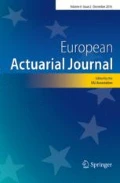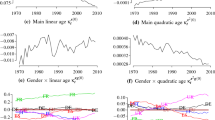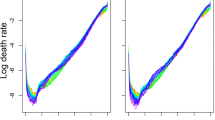Abstract
This paper proposes a multi-level hierarchical credibility regression approach to model multi-population mortality data. Future mortality rates are derived using extrapolation techniques, while the forecasting performances between the proposed model, the original Lee–Carter model and two Lee–Carter extensions for multiple populations are compared for both genders of three northern European countries with small populations (Ireland, Norway, Finland). Empirical illustrations show that the proposed method produces more accurate forecasts than the Lee–Carter model and its multi-population extensions.




Similar content being viewed by others
Notes
According to the World Bank database (https://data.worldbank.org/indicator/SP.POP.TOTL), the total population for 2018 was 4.85 million for Ireland, 5.31 for Norway and 5.52 for Finland.
References
Antonio K, Bardoutsos A, Ouburg W (2015) Bayesian Poisson log-bilinear models for mortality projections with multiple populations. Eur Actuar J 5(2):245–281
Apicella G, Dacorogna M, Di Lorenzo E, Sibillo M (2019) Improving the forecast of longevity by combining models. N Am Actuar J 23(2):298–319
Bauwelinckx T, Goovaerts MJ (1990) On a multilevel hierarchical credibility algorithm. Insur Math Econ 9:221–228
Bozikas A, Pitselis G (2019) Credible regression approaches to forecast mortality for populations with limited data. Risks 7(1):27
Bozikas A, Pitselis G (2020) Incorporating crossed classification credibility into the Lee-Carter model for multi-population mortality data. Insur Math Econ 93:353–368
Bühlmann H (1967) Experience rating and credibility. ASTIN Bull 4(3):199–207
Bühlmann H, Straub E (1970) Glaubwürdigkeit für schadensätze. Bull Swiss Assoc Actuaries 70:111–133
Bühlmann H, Gisler A (2005) A course in credibility theory and its applications. Springer, New York
Cairns AJ, Blake D, Dowd K (2006) A two-factor model for stochastic mortality with parameter uncertainty: theory and calibration. J Risk Insur 73(4):687–718
Cairns AJ, Blake D, Dowd K, Coughlan GD, Khalaf-Allah M (2011) Bayesian stochastic mortality modeling for two populations. ASTIN Bull 41(1):29–59
Carter LR, Lee RD (1992) Modeling and forecasting US sex differentials in mortality. Int J Forecast 8(3):393–411
Chen H, MacMinn R, Sun T (2015) Multi-population mortality models: a factor copula approach. Insur Math Econ 63:135–146
Chen RY, Millossovich P (2018) Sex-specific mortality forecasting for UK countries: a coherent approach. Eur Actuar J 8(1):69–95
D’Amato V, Haberman S, Piscopo G, Russolillo M (2012) Modelling dependent data for longevity projections. Insur Math Econ 51(3):694–701
D’Amato V, Haberman S, Piscopo G, Russolillo M, Trapani L (2014) Detecting common longevity trends by a multiple population approach. N Am Actuar J 18(1):139–149
De Vylder FE (1976) Geometrical credibility. Scand Actuar J 1976(3):121–149
De Vylder FE (1996) Advanced risk theory: a self-contained introduction. Ed. de l’Univ. de Bruxelles
Diao L, Weng C (2019) Regression tree credibility model. N Am Actuar J 23(2):169–196
Dowd K, Cairns AJ, Blake D, Coughlan GD, Khalaf-Allah M (2011) A gravity model of mortality rates for two related populations. N Am Actuar J 15(2):334–356
Frees EW, Shi P, Valdez EA (2009) Actuarial applications of a hierarchical insurance claims model. ASTIN Bull 39(1):165–197
Frees EW, Valdez EA (2008) Hierarchical insurance claims modeling. J Am Stat Assoc 103(484):1457–1469
Frees EW, Young VR, Luo Y (1999) A longitudinal data analysis interpretation of credibility models. Insur Math Econ 24(3):229–247
Gong Y, Li Z, Milazzo M, Moore K, Provencher M (2018) Credibility methods for individual life insurance. Risks 6(4):144
Goovaerts MJ, Kaas R, Van Heerwaarden AE, Bauwelinckx T (1990) Effective actuarial methods. North-Holland, Amsterdam
Hachemeister C (1975) Credibility for regression models with application to trend (reprint). In: Kahn P (ed) Credibility: theory and applications. Academic Press, Inc., New York, pp 307–348
Hahn LJ, Christiansen MC (2019) Mortality projections for non-converging groups of populations. Eur Actuar J 9:483–518
Hardy MR, Panjer HH (1998) A credibility approach to mortality risk. ASTIN Bull 28(2):269–283
Hatzopoulos P, Haberman S (2009) A parameterized approach to modeling and forecasting mortality. Insur Math Econ 44(1):103–123
Hatzopoulos P, Haberman S (2011) A dynamic parameterization modeling for the age-period-cohort mortality. Insur Math Econ 49:155–174
Human Mortality Database (2018) University of California, Berkeley (USA), and Max Planck Institute for Demographic Research (Germany). https://www.mortality.org. Accessed 23 Oct 2018
Hyndman RJ, Ullah MS (2007) Robust forecasting of mortality and fertility rates: A functional data approach. Comput Stat Data Anal 51(10):4942–4956
Jewell WS (1975) The use of collateral data in credibility theory: a hierarchical model. Giornale dell’Istituto Italiano degli Attuari 38:1–16
Kleinow T (2015) A common age effect model for the mortality of multiple populations. Insur Math Econ 63:147–152
Klugman SA, Panjer HH, Willmot GE (2012) Loss models: from data to decisions, vol 715. Wiley, New York
Lee RD, Carter LR (1992) Modeling and forecasting U.S. mortality. J Am Stat Assoc 87(419):659–671
Li JSH, Hardy MR (2011) Measuring basis risk in longevity hedges. N Am Actuar J 15(2):177–200
Li JSH, Zhou R, Hardy M (2015) A step-by-step guide to building two-population stochastic mortality models. Insur Math Econ 63:121–134
Li N, Lee R (2005) Coherent mortality forecasts for a group of populations: an extension of the Lee-Carter method. Demography 42(3):575–594
Lin T, Tsai CCL (2015) A simple linear regression approach to modeling and forecasting mortality rates. J Forecast 34(May):543–559
Norberg R (1980) Empirical Bayes credibility. Scand Actuar J 1980(4):177–194
Norberg R (1986) Hierarchical credibility: analysis of a random effect linear model with nested classification. Scand Actuar J 3–4:204–222
Ohlsson E (2005) Simplified estimation of structure parameters in hierarchical credibility. In: The 36th ASTIN Colloquium, Zürich (2005). http://www.actuaries.org/ASTIN/Colloquia/Zurich/Ohlsson.pdf. Accessed 28 Sep 2020
Ohlsson E (2008) Combining generalized linear models and credibility models in practice. Scand Actuar J 2008(4):301–314
Plat R (2009) On stochastic mortality modeling. Insur Math Econ 45(3):393–404
R Core Team (2018) R: A language and environment for statistical computing. R Foundation for Statistical Computing, Vienna, Austria. https://www.R-project.org/. Accessed 20 Dec 2018
Renshaw AE, Haberman S (2006) A cohort-based extension to the Lee–Carter model for mortality reduction factors. Insur Math Econ 38(3):556–570
Salhi Y, Thérond PE (2018) Age-specific adjustment of graduated mortality. ASTIN Bull 48(2):543–569
Salhi Y, Thérond PE, Tomas J (2016) A credibility approach of the Makeham mortality law. Eur Actuar J 6(1):61–96
Schinzinger E, Denuit MM, Christiansen MC (2016) A multivariate evolutionary credibility model for mortality improvement rates. Insur Math Econ 69:70–81
Sundt B (1979) A hierarchical credibility regression model. Scand Actuar J 1979(2–3):107–114
Sundt B (1980) A multi-level hierarchical credibility regression model. Scand Actuar J 1980(1):25–32
Taylor GC (1979) Credibility analysis of a general hierarchical model. Scand Actuar J 1979(1):1–12
Tsai CCL, Lin T (2017a) A Bühlmann credibility approach to modeling mortality rates. N Am Actuar J 21(2):204–227
Tsai CCL, Lin T (2017) Incorporating the Bühlmann credibility into mortality models to improve forecasting performances. Scand Actuar J 5:419–440
Tsai CCL, Wu AD (2020a) Incorporating hierarchical credibility theory into modelling of multi-country mortality rates. Insur Math Econ 91:37–54
Tsai CCL, Wu AD (2020b) Bühlmann credibility-based approaches to modeling mortality rates for multiple populations. N Am Actuar J 24(2):290–315
Tsai CCL, Zhang Y (2019) A multi-dimensional Bühlmann credibility approach to modeling multi-population mortality rates. Scand Actuar J 5:406–431
Wilson C (2001) On the scale of global demographic convergence 1950–2000. Populat Dev Rev 27:155–171
Zehnwirth B (1982) Conditional linear Bayes rules for hierarchical models. Scand Actuar J 1982(3–4):143–154
Acknowledgements
The authors thank the anonymous referees for their valuable comments and acknowledge the partial support from the University of Piraeus Research Center. This work was presented at the 3rd International Congress on Actuarial Science and Quantitative Finance in Manizales, Colombia 2019.
Author information
Authors and Affiliations
Corresponding author
Additional information
Publisher's Note
Springer Nature remains neutral with regard to jurisdictional claims in published maps and institutional affiliations.
Appendices
Appendix
A Lee–Carter mortality modelling for multiple populations: a review of methods
We review the original Lee–Carter [35] model and its most popular and widely applied extensions for multiple populations, the joint-k model presented by Carter and Lee [11] and the augmented common factor model proposed by Li and Lee [38].
1.1 The Lee–Carter model
In its original form, the Lee–Carter model links the natural logarithm of the observed \(\log m_{t,xgc}\) mortality rates with the following model predictor
where \(\alpha _{xgc}^{(1)}\) parameter reflects the average mortality at age x, gender g and country c, \(\kappa _{t,gc}\) parameter indicates the general level of mortality for gender g and country c in year t and \(\alpha _{xgc}^{(2)}\) parameter shows the deviation from the average mortality at age x, gender g and country c, as the general level of mortality changes. The errors \(\epsilon _{t,xgc}\) are expected to be normally distributed, with zero mean and constant variance, reflecting effects not captured by the model. Thus, after assuming that errors are independent and homoscedastic with zero mean, Lee and Carter [35] suggested a close approximation to the SVD (Singular Value Decomposition) method, under the constraints \(\textstyle \sum _{x = x_1}^{x_{k}} \alpha _{xgc}^{(2)} = 1\) and \(\textstyle \sum _{t = t_1}^{t_{n}} \kappa _{t,gc} = 0\), to obtain the following parameter estimates
The period estimates \({{\widehat{\kappa }}}_{t,gc}\) are extrapolated using time series methods. Lee and Carter [35] suggested a random walk with a drift parameter \({{\widehat{\theta }}}_{gc}\) to project period parameter for \(h = 1, 2, \ldots , H\) years ahead, according to \({\widehat{\kappa }}_{t_{n} + h,gc} = {\widehat{\kappa }}_{t_{n},gc} + {{\widehat{\theta }}}_{gc} h\). Then, projected values of \(\kappa _{t,gc}\) are utilized along with the estimates of age parameters \(\alpha _x^{(1)}\) and \(\alpha _x^{(2)}\) to obtain the following mortality forecasts
1.2 The joint-K model
Carter and Lee [11] proposed a model structure for multiple populations, in which mortality is jointly driven by a single period parameter \(K_{t}\) as follows
where \(\alpha _{xgc}^{(1)}\) and \(\alpha _{xgc}^{(2)}\) are defined as in the original Lee–Carter model, but now, \(K_{t}\) is the common period parameter of the mortality level in year t for gender g and country c. Errors \(\epsilon _{t,xgc}\) are assumed independent and identically distributed. Then, constraints \(\textstyle \sum _{c = 1}^{C} \sum _{g = 1}^{G} \sum _{x = x_{1}}^{x_{k}} \alpha _{xgc}^{(2)} = 1\) and \(\textstyle \sum _{t = t_{1}}^{t_{n}} K_{t} = 0\) lead to the following parameter estimates
and
The common period parameter \({{\widehat{K}}}_{t}\) is assumed to follow a random walk with a drift \(\theta\), \({{\widehat{K}}}_{t} = {{\widehat{K}}}_{t-1} + \theta + \varepsilon _{t}\), where the time trend errors \(\varepsilon _{t}\) are again assumed to be independent and identically distributed, and independent of the model errors \(\epsilon _{t,xgc}\). The drift parameter is estimated by \(\textstyle {{\widehat{\theta }}} = \frac{1}{t_{n}-t_{1}}\sum _{t=t_{1}+1}^{t_{n}}\left( {{\widehat{K}}}_{t} - {{\widehat{K}}}_{t-1}\right) = \frac{{{\widehat{K}}}_{t_{n}} - \widehat{K}_{t_{1}}}{n-1}\) and then it used to project period estimates \(\textstyle {{\widehat{K}}}_{t_{n} + h} = {{\widehat{K}}}_{t_{n}} + \widehat{\theta }h\). Thus, projected mortality rates for \(h = 1, 2, \ldots\) years ahead, for age x, gender g and country c are given by
1.3 The augmented common factor model
To avoid long-run divergence in mean mortality forecasts for multiple countries, Li and Lee [38] modified the original Lee–Carter model by setting a common age parameter \(\alpha _{x}^{(2)}\) and the same period parameter \(K_{t}\) for all populations as follows
Again, we use two constraints \(\textstyle \sum _{c = 1}^{C} \sum _{g = 1}^{G} \sum _{x = x_{1}}^{x_{k}} w_{gc} \alpha _{x}^{(2)} = 1, \ \text {and} \ \sum _{t = t_{1}}^{t_{n}} K_{t} = 0\), where \(w_{gc}\) is the weight for gender g in country c, set to be proportional to the total number of populations, i.e., \(w_{gc} = 1/(G C)\). The model parameters are estimated by
and
To include the individual differences in the trends, Li and Lee [38] suggested an additional factor \(\alpha _{xgc}^{(3)} \kappa _{t,gc}\) to form the augmented common factor model
Assuming the extra constraint \(\textstyle \sum _{x=x_{1}}^{x_{k}} \alpha _{xgc}^{(3)} = 1\), the additional parameters are estimated as
and
Both period parameters \({{\widehat{K}}}_{t}\) and \(\widehat{\kappa }_{t,gc}\) follow a random walk model with a drift, given by \({{\widehat{K}}}_{t} = {{\widehat{K}}}_{t-1} + \theta + \varepsilon _{t}\) and \({{\widehat{\kappa }}}_{t,gc} = {{\widehat{\kappa }}}_{t-1,gc} + \theta _{gc} + \varepsilon _{t,gc}\), respectively, where time trend errors \(\varepsilon _{t}\) and \(\varepsilon _{t,gc}\) are assumed to be independent and identically distributed, and independent of the model error \(\epsilon _{t,xgc}\). The drift parameters can be estimated by
and
Then, projected mortality rates for \(h = 1, 2, \ldots\) years ahead, for age x, gender g and country c are obtained by
We can easily observe that expressions (63), (65) and (67) are linear functions of the forecasting horizon h, where their intercept equal to the fitted rates of the last observed year and their slope is the product of the estimated age parameters with the drift terms.
B Proof of Theorem 1
Expressions (18)–(22) are notations. Expression (23) can be easily proved using assumptions (A6) and (4)
From (18), we can easily get (24)
while from (20) we can prove (25)
The first part of (26) can be proved by (22) and (25)
Also, (6) gives
and via (7), we can get
\(\square\)
C Proof of Theorem 2
Expression (27) is proved as follows
Similarly, we can obtain (28) and (29) as
Expression (30) can be proved by
For expression (31) we have
Similarly, we can prove (32). Expression (33) is obtained as
and (34) can be proved in the same way. From expression (31), we can prove (35) as
and similarly, we can get (36). Expression (37) is obtained by (33) as follows
while (38) yields similarly. Expression (39) can be proved via (38)
and similarly we can prove (40). Expression (41) can be obtained using (39) as follows
while (42) can be obtained as \({\text{ Cov }}\left( \widehat{\varvec{\beta }}_{c}, \widehat{\varvec{\beta }}\right) = {\text{ Cov }}\left( \widehat{\varvec{\beta }}, \widehat{\varvec{\beta }}_{c}\right) ^{'} = \varvec{\varPsi } \left( \sum _{c'=1}^{C}{\varvec{K}}_{c'}^{'}\right) ^{-1}\). Finally, expression (43) can be proved using (41)
\(\square\)
D Proof of Lemma 1
-
(a)
For country level it is sufficient to show that (53) satisfies (47) and (48) of Theorem 3. Expectation unbiasedness holds from (26) and (22) as follows
$$\begin{aligned} E\left[ \varvec{\beta }_{c}^{Cred}\left( \varTheta _{c}^{+3}\right) \right]&= E\left[ {\varvec{K}}_{c} \ \widehat{\varvec{\beta }}_{c} + \left( {\varvec{I}}_{2}-{\varvec{K}}_{c}\right) \ \varvec{\beta }\right] \nonumber \\&= {\varvec{K}}_{c} \ E\left[ \widehat{\varvec{\beta }}_{c}\right] + \left( {\varvec{I}}_{2}-{\varvec{K}}_{c}\right) \ \varvec{\beta } \nonumber \\&= \varvec{\beta }, \end{aligned}$$(68)which is equal to \(E\left[ \varvec{\beta }\left( \varTheta _{c}^{+3}\right) \right]\). The covariance condition is proved using expressions (35) and (29).
$$\begin{aligned} {\text{ Cov }}\left[ \varvec{\beta }_{c}^{Cred}\left( \varTheta _{c}^{+3}\right) , \widehat{\varvec{\beta }}_{x'g'c'} \right)&= {\text{ Cov }}\left[ {\varvec{K}}_{c} \ \widehat{\varvec{\beta }}_{c}+\left( {\varvec{I}}_{2}-{\varvec{K}}_{c}\right) \ \varvec{\beta },\widehat{\varvec{\beta }}_{x'g'c'}\right] \nonumber \\&={\varvec{K}}_{c} \ {\text{ Cov }}\left( \widehat{\varvec{\beta }}_{c},\widehat{\varvec{\beta }}_{x'g'c'}\right) + ({\varvec{I}}_{2}-{\varvec{K}}_{c}) \ {\text{ Cov }}\left( \varvec{\beta } ,\widehat{\varvec{\beta }}_{x'g'c'}\right) \nonumber \\&= \varvec{\varPsi }\left[ \varvec{\varPsi } + \left( \sum _{g=1}^{G_{c}}{\varvec{K}}_{gc}\right) ^{-1}{\varvec{U}}\right] ^{-1} \delta _{cc'} \left[ \left( \sum _{g=1}^{G_{c}}{\varvec{K}}_{gc}\right) ^{-1}{\varvec{U}} + \varvec{\varPsi }\right] \nonumber \\&= \delta _{cc'} \varvec{\varPsi }, \end{aligned}$$(69)which is equal to \({\text{ Cov }}\left[ \varvec{\beta }\left( \varTheta _{c}^{+3}\right) ,\widehat{\varvec{\beta }}_{x'g'c'}\right]\).
-
(b)
Similarly, for gender level it is sufficient to show that (54) satisfies (49) and (50). The expectation condition can be proved by (68), (26) and (24) as
$$\begin{aligned} E\left[ \varvec{\beta }_{gc}^{Cred}\left( \varTheta _{gc}^{+23}\right) \right]&= E\left[ {\varvec{K}}_{gc}\widehat{\varvec{\beta }}_{gc}+\left( {\varvec{I}}_{2}-{\varvec{K}}_{gc}\right) \ \varvec{\beta }^{Cred}\left( \varTheta _{c}^{+3}\right) \right] \nonumber \\&= {\varvec{K}}_{gc}E\left[ \widehat{\varvec{\beta }}_{gc}\right] +\left( {\varvec{I}}_{2}-{\varvec{K}}_{gc}\right) \ E\left[ \varvec{\beta }^{Cred}\left( \varTheta _{c}^{+3}\right) \right] \nonumber \\&= \varvec{\beta } = E\left( \widehat{\varvec{\beta }}_{xgc}\right) = E\left[ E\left( \widehat{\varvec{\beta }}_{xgc}\big |\varTheta _{gc}^{+23}\right) \right] = E\left[ {{\varvec{\beta }}}\left( \varTheta _{gc}^{+23}\right) \right] . \end{aligned}$$(70)Then, from (33), (69) and (28) we get
$$\begin{aligned}&{\text{ Cov }}\left[ \varvec{\beta }_{gc}^{Cred}\left( \varTheta _{gc}^{+23}\right) , \widehat{\varvec{\beta }}_{x'g'c'}\right] \nonumber \\&\quad = {\text{ Cov }}\left[ {\varvec{K}}_{gc}\widehat{\varvec{\beta }}_{gc}+\left( {\varvec{I}}_{2}-{\varvec{K}}_{gc}\right) \ \varvec{\beta }^{Cred}\left( \varTheta _{c}^{+3}\right) ,\widehat{\varvec{\beta }}_{x'g'c'}\right] \nonumber \\&\quad = {\varvec{K}}_{gc}{\text{ Cov }}\left( \widehat{\varvec{\beta }}_{gc},\widehat{\varvec{\beta }}_{x'g'c'}\right) + \left( {\varvec{I}}_{2}-{\varvec{K}}_{gc}\right) \ {\text{ Cov }}\left[ \varvec{\beta }^{Cred}\left( \varTheta _{c}^{+3}\right) ,\widehat{\varvec{\beta }}_{x'g'c'}\right] \nonumber \\&\quad = {\varvec{U}}\left[ {\varvec{U}} + \left( \sum _{x=x_1}^{x_{k_{gc}}}{\varvec{K}}_{xgc}\right) ^{-1}{\varvec{A}}\right] ^{-1} \left\{ \delta _{cc'} \{\delta _{gg'}\left[ \left( \sum _{x=x_1}^{x_{k_{gc}}}{\varvec{K}}_{xgc}\right) ^{-1} \ {\varvec{A}} + \ {\varvec{U}}\right] + \varvec{\varPsi }\}\right\} \nonumber \\&\qquad + \left\{ {\varvec{I}}_{2}-{\varvec{U}}\left[ {\varvec{U}} +\left( \sum _{x=x_1}^{x_{k_{gc}}}{\varvec{K}}_{xgc}\right) ^{-1}{\varvec{A}}\right] ^{-1} \right\} \ \delta _{cc'} \varvec{\varPsi } \nonumber \\&\quad = \delta _{cc'} \left( \delta _{gg'} {\varvec{U}} + \varvec{\varPsi }\right) , \end{aligned}$$(71)which is equal to \({\text{ Cov }}[\varvec{\beta }(\varTheta _{gc}^{+23}),\widehat{\varvec{\beta }}_{x'g'c'}]\).
-
(c)
Finally, for the estimator (55) of age level, we have to prove (51) and (52). For the expectation condition, we use (26), (70) and (S1) as follows
$$\begin{aligned} E\left[ \varvec{\beta }_{xgc}^{Cred}\left( \varTheta _{xgc}^{+123}\right) \right]&= E\left[ {\varvec{K}}_{xgc}\widehat{\varvec{\beta }}_{xgc}+\left( {\varvec{I}}_{2}-{\varvec{K}}_{xgc}\right) \ \varvec{\beta }^{Cred}\left( \varTheta _{gc}^{+23}\right) \right] \nonumber \\&= {\varvec{K}}_{xgc}E\left( \widehat{\varvec{\beta }}_{xgc}\right) +\left( {\varvec{I}}_{2}-{\varvec{K}}_{xgc}\right) \ E\left[ \varvec{\beta }^{Cred}\left( \varTheta _{gc}^{+23}\right) \right] \nonumber \\&= \varvec{\beta }, \end{aligned}$$(72)which is equal to \(E\left[ \varvec{\beta }\left( \varTheta _{xgc}^{+123}\right) \right]\). For the covariance, the proof is given by using (30), (71) and (27).
$$\begin{aligned}&{\text{ Cov }}\left[ \varvec{\beta }_{xgc}^{Cred}\left( \varTheta _{xgc}^{+123}\right) ,\widehat{\varvec{\beta }}_{x'g'c'}\right] \nonumber \\&\quad = {\text{ Cov }}\left[ {\varvec{K}}_{xgc} \ \widehat{\varvec{\beta }}_{xgc} + \left( {\varvec{I}}_{2}-{\varvec{K}}_{xgc}\right) \ \varvec{\beta }^{Cred}\left( \varTheta _{gc}^{+23}\right) , \widehat{\varvec{\beta }}_{x'g'c'}\right] \nonumber \\&\quad = {\varvec{K}}_{xgc}{\text{ Cov }}\left( \widehat{\varvec{\beta }}_{xgc},\widehat{\varvec{\beta }}_{x'g'c'}\right) \nonumber \\&\qquad + \left( {\varvec{I}}_{2}-{\varvec{K}}_{xgc}\right) \ {\text{ Cov }}\left[ \varvec{\beta }^{Cred}\left( \varTheta _{gc}^{+23}\right) ,\widehat{\varvec{\beta }}_{x'g'c'}\right] \nonumber \\&\quad = {\varvec{K}}_{xgc} \delta _{cc'} \left\{ \delta _{gg'}\left[ \delta _{xx'}\left( {\varvec{A}}+s^{2}\left( {\varvec{Z}}_{xgc}^{'}{\varvec{W}}_{xgc} {\varvec{Z}}_{xgc}\right) ^{-1}\right) +{\varvec{U}}\right] + \varvec{\varPsi }\right\} \nonumber \\&\qquad + \left( {\varvec{I}}_{2}-{\varvec{K}}_{xgc}\right) \ \delta _{cc'} \left( \delta _{gg'} {\varvec{U}} + \varvec{\varPsi }\right) \nonumber \\&\quad = \delta _{cc'} \left[ \delta _{gg'}\left( \delta _{xx'} {\varvec{A}} + {\varvec{U}}\right) + \varvec{\varPsi }\right] , \end{aligned}$$(73)which is equal to \({\text{ Cov }}\left[ \varvec{\beta }\left( \varTheta _{xgc}^{+123}\right) ,\widehat{\varvec{\beta }}_{x'g'c'}\right]\). \(\square\)
E Proof of Theorem 4
For the proof of expression (56) let
where \(E\left( {\varvec{Y}}_{xgc}{\varvec{Y}}_{xgc}^{'}\right) = s^2 \ {\varvec{W}}_{xgc}^{-1} + {\varvec{Z}}_{xgc} \varvec{\beta } \ \varvec{\beta }^{'} {\varvec{Z}}_{xgc}^{'} \ .\) By recalling the linearity of trace, we take
that proves (56).
For the proof of (57), we use (30)–(33) as follows
Similarly, (58) is proved via (34), (37), (38) and (39) as follows
Finally, (59) is obtained by using (40)–(43) as follows
\(\square\)
Rights and permissions
About this article
Cite this article
Bozikas, A., Pitselis, G. Multi-population mortality modelling and forecasting: a hierarchical credibility regression approach. Eur. Actuar. J. 11, 231–267 (2021). https://doi.org/10.1007/s13385-020-00248-9
Received:
Revised:
Accepted:
Published:
Issue Date:
DOI: https://doi.org/10.1007/s13385-020-00248-9




